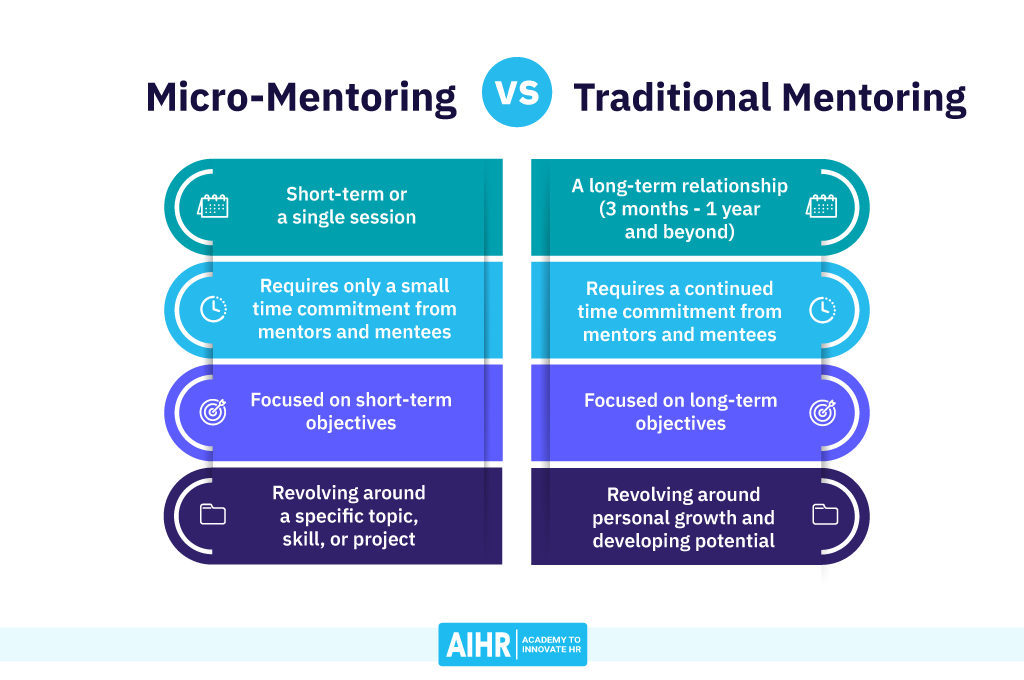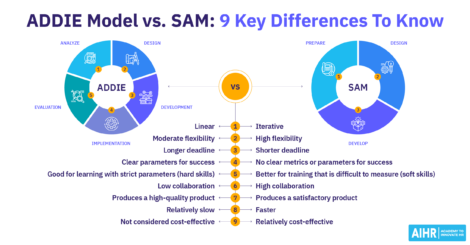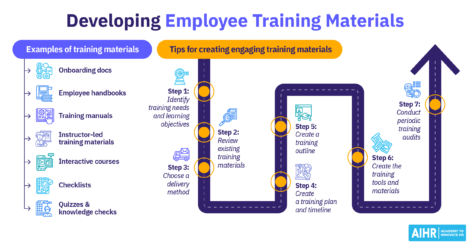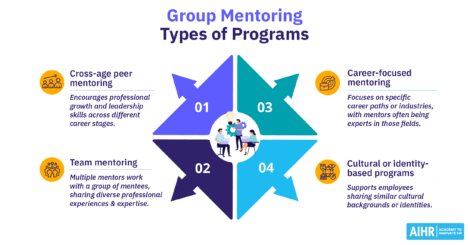Micro-Mentoring: All You Need to Know

Having ample opportunities to develop new skills and competencies is essential for employees and organizations. Micro-mentoring is a great way to enable employees to gain skills and network with their colleagues. Let’s look at micro-mentoring, its benefits for your employees and the organization, and best practices.
Contents
What is micro-mentoring?
What are the benefits of micro-mentoring?
Micro-mentoring best practices
What is micro-mentoring?
Micro-mentoring is an innovative form of workplace mentoring that is short in duration and usually occurs in the space of just a few hours or over a few days. Other terms referring to this type of mentoring include short-term mentoring, one-time mentoring, flash mentoring, and session-based mentoring.
Examples of micro-mentoring include one-time meetings revolving around a specific topic or skill, standalone mentoring events, or “speed mentoring” events.
Micro-mentoring isn’t meant to replace traditional longer-term mentoring or other employee development initiatives, but rather to supplement them and create another learning and relationship-building opportunity for employees.
As explained by Charterhouse.org, micro-mentoring reduces some of the pressures of mentoring by finding ways to build shorter relationships. It’s beneficial in organizations and industries where employees want to address specific work issues like technical job expertise, career advancement, or client relationship management.
What are the benefits of micro-mentoring?
This mentoring format has multiple benefits for the employees and the organization.
It is informal and accessible
There are fewer barriers to access compared to a formal mentoring program, both for mentors and mentees. For example, it requires a reduced time commitment from both parties.
Both parties can have a one-off meeting at their own convenience without requiring a follow-up (if mentor and mentee agree) that may conflict with other commitments.
Micro-mentoring can be particularly effective for experienced and busy mentors, making them more accessible to mentees. They can also interact with more mentees over time. It enables mentees to speak with mentors quickly to get what they need to succeed.
Because the duration doesn’t require much time to build a relationship, the expectation is that the relationship doesn’t need to continue if neither party requires it. Having a mentoring mismatch or an unpleasant mentoring relationship that didn’t work out doesn’t need to cause uneasiness in the workplace.
Providing exposure to different people
It becomes more accessible for the participants to meet people from other departments across the business.
Junior staff can connect with peers enabling them to build robust professional networks within the company.
Individuals desiring career progression will benefit from interacting with key senior employees; a positive micro-mentoring session can leave a good lasting impression that can lead to referrals for future promotions or training.
It can help employees develop professionally and progress within the organization by finding a mentor who can explain the position and how they become successful in it or seeking help to get promoted.
It is suitable for anyone in different careers, depending on their needs
Short-term mentoring can be arranged between colleagues or individuals to reskill or upskill. This opens the possibilities to anyone within the company and isn’t just for one particular goal.
Bite-sized knowledge transfer
Transferring knowledge can ultimately help employee retention and the overall organizational learning strategy.
It enables mentees to quickly connect with a mentor and receive expert advice or develop specific skills that they can put into practice immediately.
Ingesting information in small doses also allows mentees to remember what they’ve learned because content that’s quick and focused on one topic helps with learner retention.
Work environments and industries are rapidly changing. Hence, jobs are becoming more agile, and employees need to learn new skills quickly.
Employers can use flash mentoring to help their staff to develop their skills and knowledge to fit any new environment.
Enhancing collaboration and performance
Micro-mentoring helps connect people from different departments, enhancing cross-departmental collaboration and breaking down silos.
Short-term mentoring is an efficient way of bringing lagging team members up to speed and discovering areas for improvement. For example, if the performance gap is communication-related, one meeting can establish the need for additional training to work on shortcomings.
Improving engagement and retention
Providing plenty of opportunities to develop their skills helps engage and retain employees.
Micro-mentoring can boost job satisfaction and employee morale. It shows that the organization takes employees’ needs for development seriously. It’s also a great way to support the company’s L&D initiatives.
What’s more, it provides an opportunity for individuals to start pursuing their career goals.
Working well with other mentoring programs
Micro-mentoring builds a more comprehensive mentoring environment, allowing participants to strengthen their professional development efforts to reach targeted outcomes.
It could also be a great approach to starting a more traditional mentoring relationship. You can use it to ease employees into formal mentoring to give a glimpse of how the system works and the kind of career advice they can receive from mentors.
If micro-mentoring was successful, it could be arranged to turn it into long-term mentoring, if schedules permit. Or the sessions can be the motivation for someone to pursue a more formal mentorship.
Micro-mentoring best practices
Now that you know all about the benefits of micro-mentoring, let’s dive into how your employees and your organization can make the most out of it.
1. Understand your employees’ needs
Get to know your employees’ learning needs and interests. That enables you to find the most effective ways to facilitate micro-mentoring at your organization.
Identify prospective mentees that your micro-mentorship will target and check how these employees will benefit by determining their professional journeys, career development needs, and motivation.
Set goals for your micro-mentorship with who will be your typical mentee in mind. Establish SMART goals: Specific, Measurable, Attainable, Relevant, and Time-bound.
For example, a SMART goal or your micro-mentoring initiative could be: Achieve a self-reported improvement of 10% in sales skills of employees participating in the program within Q2.
2. Select mentors
It’s vital to carefully select the employees who will be mentors in your micro-mentoring program.
To say the least, they should be role models and show strong leadership skills. Identify those who demonstrate outstanding work performance, sound decision-making, problem-solving, and communication skills. Look for employees who also might benefit from being a mentor, for example, aspiring managers and leaders.
If possible, have more than one mentor per mentee. Mentees need diverse advice and perspectives to make the best decisions.
3. Promote your company’s micro-mentoring initiatives
It’s vital for everyone in the company to know about the micro-mentoring program and how they might benefit from it.
This might compel employees to join as mentors or mentees. It might also motivate them to evaluate their own performance as they consider whether they are fit to join or not.
You can do this via the company’s newsletter, your company’s intranet, or internal communication channels like Slack.
For example, an American medical technology Edwards Lifesciences organizes two-hour speed mentoring events focusing on career development. Mentees speak with a different mentor every ten minutes. The HR team makes sure to communicate the objective of the event in advance. For mentees, it can be career enrichment or DEIB, while for mentors, it can be the opportunity to give back despite their busy schedules.
4. Educate your employees about how to engage in micro-mentoring
This goes for both people seeking short-term mentorship and people who could provide mentoring.
At Edwards Lifesciences, mentees receive a sample list of questions they can use to prepare their own questions to ask the mentors before each speed mentoring event. Mentors get instructions on what kind of questions they can expect to be able to prepare.
Here are some tips for mentors and mentees for a productive micro-mentoring session:
Tips for mentors
- Before the mentoring, review the mentee’s goals and objectives for the mentorship.
- During the mentoring session, encourage your mentee to communicate openly. Pay attention to non-verbal cues. Ask open-ended questions to get more details and information. Use your own experience to share knowledge, like challenges and how you overcome them. Provide constructive feedback that is specific and detailed. Suggest other people who might also offer additional insights. Conclude the mentorship with an action plan for the mentee.
- After the mentorship, follow up on any agreements you made with your mentee. Express your appreciation to the mentee for what you personally might have learned from the mentorship.
Tips for mentees
- Before the micro-mentorship session, evaluate your goals for joining. Send an email to your mentor with a list of topics to cover during the meeting. Be clear with your expectations. Schedule a place and time for the mentoring session.
- During micro-mentoring, be open-minded and willing to learn new ideas. Share your goals and challenges. Don’t be afraid to ask questions. Ask recommendations for learning and continuous development resources. Close the session with a proposed action plan for your next steps.
- After the session, follow up on any agreements you made with your mentor. Thank your mentor and share feedback on how the mentorship helped you.
5. Consider remote micro-mentorship
The emerging hybrid or remote work arrangements also bring to light the opportunity for conducting mentoring sessions remotely.
For a remote micro-mentorship, leverage technology like email, chat, or video conferencing as a substitute for in-person meetings. For example, encourage interacting via video call for a more focused discussion. Or use instant messaging or chat for quick updates, check-ins, and information sharing.
It’s important that the participants treat these meetings with the same confidentiality and courtesy as they would in a typical face-to-face mentorship session.
6. Gather feedback and implement improvements
Ask mentors and mentees how they’re finding the micro-mentoring activities. For instance, you can send a short survey after a micro-mentoring event.
In your survey, ask what improvements they would like to see, what areas of work they need more help and other questions they might have.
Based on the feedback you’ve gathered, performance reviews, and survey results, you can create an action plan for how to improve your micro-mentoring program.
For example, you might consider implementing software to facilitate micro-mentoring at your organization. Tools like MentorEase or Chronus help you automate matching mentors and mentees based on their profiles, administrate surveys, and more.
7. Include micro-mentoring in your overall employee development strategy
Micro-mentoring is just one of the tools in your employee development arsenal. It can be part of a more extensive mentoring program and your overall Learning & Development strategy.
If you want to learn more about developing an L&D strategy that aligns with your business strategy and goals, check out our Learning & Development Certificate Program!
Conclusion
As an HR professional, you can help introduce micro-mentoring into your organization and empower your employees to find micro-mentoring opportunities. It can be an excellent avenue for your employees to learn different things from different people and for your organization to retain them for longer and bridge the skills gaps.
Weekly update
Stay up-to-date with the latest news, trends, and resources in HR
Learn more
Related articles
Are you ready for the future of HR?
Learn modern and relevant HR skills, online













